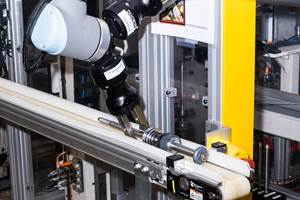Forging A New Strategy
A manufacturer of automotive parts successfully adopts high speed machining to improve the production of tooling for its forging operations.
Share

.png;maxWidth=45)
DMG MORI - Cincinnati
Featured Content
View More


Hwacheon Machinery America, Inc.
Featured Content
View More
Takumi USA
Featured Content
View More



Autodesk, Inc.
Featured Content
View More

ECi Software Solutions, Inc.
Featured Content
View MoreBy their very nature, manufacturing operations are resistant to fundamental changes in production strategies. When reconfiguring a high-volume production process, therefore, the consequences of miscalculation are momentous enough to give managers the sensation of climbing onto a lofty tree limb. With gazes fixed on the ground below, the players in this scenario realize that they’re working without a safety net.
TRW Automotive (St. Catharines, Ontario, Canada) faced this type of challenge when toolroom managers in the firm’s steering and suspension systems division began to investigate alternatives for machining of forging dies. This investigation culminated with a total investment of $4 million to initiate a high speed machining process. When the company began its transition, however, this technology was relatively new, and choices of appropriate machine tools were quite limited. The supporting network that exists today was largely absent. For this reason, the company’s managers were obligated to blaze their own trail in developing the capabilities of this technology.
TRW Automotive is the world’s eighth largest automotive supplier, manufacturing a wide range of original equipment and aftermarket products that include braking systems, chassis parts, steering systems, occupant safety systems, engine components and engineered fasteners. With more than 25,000 employees in North America, the company recorded 2002 sales of $10.6 billion. The St. Catharines plant employs approximately 800 people, and its daily forging operations comprise three 8-hour shifts.
The impetus for changing the toolroom’s production process was internal—provided by increasing demand from the forging operations. The company needed to replace a mature production process that was no longer flexible enough to keep pace with these operations. The plant’s existing process involved creating masters of all forged parts, duplicating electrodes from these masters and machining die cavities via EDM. This required using a total of 12 ram EDMs, five duplicators, an abrader and a substantial number of operators.
A large portion of the dies machined by TRW’s toolroom is used to produce automotive suspension arms, upper control arms and ball-joint assemblies. These impression dies are exposed to very high temperatures in the continuous production of parts from induction-heated forging stock. The dies are machined from H13 steel with a hardness of 45 HRC. The company’s forging plant operates both vertical presses and horizontal (upsetter) machines.
The search for a more efficient process led the company to arrange a demonstration in which its forging dies were milled on high speed machines as an alternative to the EDM process. The results convinced managers that the company could substantially streamline its die-production process. “The demonstration proved beyond a doubt that this would give us the ability to cut hardened materials at significantly increased feed rates,” says CNC programmer Robert Chausse. But convincing the toolroom employees to embrace an entirely new machining strategy proved to be a much more gradual process. From the time when the company’s first high speed machine became operational, a transitional period of approximately 1 year was necessary before the toolroom had ramped up to full production.
Getting There
For TRW Automotive, making the change to high speed machining involved altering toolmakers’ basic assumptions about machine tool capabilities. Initially, the concept that metal can be removed more efficiently by operating new types of cutting tools at higher speeds was difficult for the company’s veteran machinists to accept at face value. Furthermore, applying the speed and feed parameters applicable to high speed machining seemed to fly in the face of toolmakers’ experiences with conventional cutting tools. And soon after installing the first of four high speed HMCs, the company encountered some obstacles that briefly heightened these doubts.
First, because high speed machining did not have a substantial track record at that time, TRW Automotive needed to experiment with various machining parameters to determine the optimal conditions for its production process. “We destroyed some spindles in the beginning because we believed that the machines could be run more aggressively than what actually proved to be the case,” says Mr. Chausse.
A second obstacle during this initial stage was the limited availability of cutting tools for high speed machines. “There were only a handful of suppliers for these tools, and the tools were very expensive,” says toolroom coordinator Norm MacLeod. “Because we didn’t have our machining process perfected for several months, we initially purchased a number of tools that we later discovered could not be used.”
This process primarily involved decisions about which diameters and sizes of cutting tools were most appropriate for the company’s machining needs. As the high speed machining process was perfected, TRW Automotive’s toolroom managers discovered that the range of tool sizes necessary was less extensive than originally expected. It soon became evident that ¼-inch- and ½-inch-diameter tools would be used in the greatest volume for the majority of the toolroom’s work.
The company also needed to locate a new CAD/CAM system suitable for high speed machining. “The software we were using at that time was not capable of generating toolpaths for roughing from stock material,” says Mr. Chausse. “Our software also could not generate Z-level toolpaths for plunging operations.”
As a result, during the 2-year period before its original software provider had developed an appropriate version, the company needed to find an alternative system and learn to operate it. This represented another roadblock during the transitional phase. While TRW Automotive’s toolmakers learned to operate the high speed machine tools, software and controllers, they also integrated new systems of material handling and tool management to support this new process. For example, in contrast to the previous practice of having shop personnel individually load and unload EDMs, the toolroom installed a pallet system to transfer dies among its battery of HMCs.
Given the dimensions of its commitment to high speed machining, the stakes were very high for TRW Automotive. “Once we had made the decision, failure simply was not an option,” says Mr. Chausse. With strong support from management, information services, engineering and its veteran team of toolmakers, the company created an effective cross-functional group to develop its new process. While it ramped up for high speed machining, however, the company faced the ongoing challenge of meeting existing production demands. For this reason, the company inaugurated its high speed process in the production of dies for a single part, and then gradually extended it throughout the entire line of tooling.
The Payoff
In successfully completing its transition, the company has gained some remarkable improvements in productivity. With the laborious process of creating masters and electrodes now being only a memory, the toolroom’s overall process time for die production has been reduced by 50 percent. The number of steps required to manufacture tooling has been reduced from nine to only six, and labor efficiency has been substantially improved. “Compared to our old method, we’re able to produce more dies today with considerably fewer people,” says Mr. MacLeod.
These gains greatly expand the company’s available options in production planning and customer service. Shorter cycle times for finished and remanufactured dies now enable the toolroom to adapt more rapidly to changes in production demands. Reduced lead times for tooling production have enabled the toolroom to adopt a JIT production scheme in its relationship to the company’s forging department. This type of flexibility was not possible with the company’s former EDM process. Furthermore, the toolroom can adapt more rapidly to the evolution of part designs.
For metalworking companies large and small, TRW Automotive’s transition underlines the importance of investigating new technologies and making an early commitment to a new process. The company’s managers realized that they couldn’t wait until their forging operations faced serious roadblocks in meeting production demands. To prepare for the needs that it has today, therefore, the firm needed to begin adopting this technology several years earlier, despite the related risks and uncertainties.
As the company’s personnel learned more about the methodology and requirements of high speed machining, their initial doubts were replaced by considerable enthusiasm about the efficiencies of the new process. Although manufacturers adopting this process today must still endure significant trial-and-error periods, improved access to related resources has shortened the learning curve, thus reducing startup costs.
In this vein, the prices of cutting tools for today’s high speed machining processes represent only a fraction of those paid by early adopters of this technology. Compared to today’s prices, for example, TRW Automotive was paying up to eight times more for certain tools when it began using high speed machining. Additionally, much more experience has been gained to guide various applications of high speed cutting tools since the time that the company made its transition.
TRW Automotive’s success demonstrates that solidarity of purpose and organizational flexibility represent the hallmarks of manufacturing organizations that successfully adapt and prosper in the arena of global competition. Well before metalworking professionals can realize the advantages of new technologies, however, some fundamental transitions in thinking and organization must occur. During this process, it’s crucial that team members do not perceive these changes as threats, but as opportunities to improve their overall production system. For managers, therefore, the challenge of guiding the organization through these changes with confidence is at least equal to that of mastering the technology.
Related Content
JIMTOF 2024 Report: EVs, AI and Autonomous Robots Abound
The 2024 Japan International Machine Tool Fair (JIMTOF) showed how the manufacturing industry is adapting to the needs of electric vehicle manufacturing and adopting new technology including AI and autonomous robots.
Read MoreFord Partners With Rockwell Automation to Advance EV Program
The companies will jointly collaborate on assembly tooling designs and architectures that will increase speed to market.
Read MoreEliminating Automotive Defects Per Million With Automated Visual Inspection
This automotive manufacturer virtually eliminated PPM defect complaints after implementing an automated visual inspection system at its facility.
Read MoreThe Role of Surface Finishing in Modern Manufacturing: Trends and Best Practices
You’re attending IMTS to advance your business. Regardless of your role in the manufacturing process, considering how your parts will be finished is crucial. This article can help you understand trends in surface finishing and better communicate with your finishing partners.
Read MoreRead Next
Setting Up the Building Blocks for a Digital Factory
Woodward Inc. spent over a year developing an API to connect machines to its digital factory. Caron Engineering’s MiConnect has cut most of this process while also granting the shop greater access to machine information.
Read MoreBuilding Out a Foundation for Student Machinists
Autodesk and Haas have teamed up to produce an introductory course for students that covers the basics of CAD, CAM and CNC while providing them with a portfolio part.
Read MoreRegistration Now Open for the Precision Machining Technology Show (PMTS) 2025
The precision machining industry’s premier event returns to Cleveland, OH, April 1-3.
Read More











































